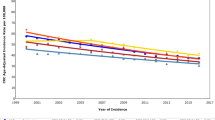Abstract
In the USA, the rate of incarceration has steadily increased from 1980 to 2010, a period called mass incarceration. Incarcerated individuals are now leaving the jail system in large numbers, the majority of whom are returning to low-income and Black and Hispanic-Latino communities. Although highly preventable, colorectal cancer (CRC) is a significant risk for minority and underserved men over the age of 50. Black men have the highest CRC incidence and mortality rates, which can be prevented and treated effectively when detected early, especially via colonoscopy. Hispanic-Latino men have the third highest CRC incidence rates and the fourth highest mortality rates. This qualitative study seeks to examine how the experience of incarceration and reintegration affects the awareness of CRC screening practices, the attitudes towards these services, the availability of services, and the frequency of CRC screening among the recently released Black and Hispanic-Latino men over the age of 50 in New York City.


Similar content being viewed by others
References
American Civil Liberty Union (ACLU). (2012) At America’s expense: the mass incarceration of the elderly
U.S. Department of Justice. (2014) Prisoners in 2013 bulletin.
Morenoff JD, Harding DJ (2014) Incarceration, prisoner reentry, and communities. Annu Rev Sociol 40:411–429
Human Rights Watch. (2012) Old behind bars: the aging prison population in the United States
NYS Department of Correction and Community Supervision. (2015) Parolee facts. Available from: https://www.parole.ny.gov/program_stats.html. Accessed April 15
American Cancer Society. (2013) Cancer facts & figures for African Americans 2013-2014
American Cancer Society. (2012) Cancer facts & figures for Hispanics/Latinos 2012-2014. American Cancer Society
Binswanger IA, White MC, Perez-Stable EJ et al (2005) Cancer screening among jail inmates: frequency, knowledge, and willingness. Am J Public Health 95:1781–1787
Ahalt C, Binswanger IA, Steinman M et al (2012) Confined to ignorance: the absence of prisoner information from nationally representative health data sets. J Gen Intern Med 27:160–166
The Sentencing Project. (2016), The facts: state by state data. Available from: http://www.sentencingproject.org/map/map.cfm. Accessed August 25
New York City Community Health Survey Atlas (2010). Available from: New York City Community Health Atlas, 2010. New York City Department of Health and Mental Hygiene
Mellow J, Hoge SK, Lee JD et al. (2008) Mapping the innovation in correctional health care service delivery in New York City, 2008
Anonymous (2009) Pew center on the states, one in 31: the long reach of American Corrections Washington, DC: The Pew Charitable Trusts
Shariff-Marco S, Gee GC, Breen N et al (2009) A mixed-methods approach to developing a self-reported racial/ethnic discrimination measure for use in multiethnic health surveys. Ethnicity & Disease 19:447–453
Addis ME, Mahalik JR (2003) Men, masculinity, and the contexts of help seeking. Am Psychol 58:5–14
Christy SM, Mosher CE, Rawl SM (2014) Integrating men’s health and masculinity theories to explain colorectal cancer screening behavior. Am J Mens Health 8:54–65
Robertson J (2003) Rape among incarcerated men: sex, coercion and STDs. AIDS Patient Care STDS 17:423
Hennelly MO (2015) Narrative message targets within the decision-making process to undergo screening colonoscopy among Latinos: a qualitative study. J Cancer Educ 30(2):268–276
Wang EA, Hong CS, Shavit S et al (2012) Engaging individuals recently released from prison into primary care: a randomized trial. Am J Public Health 102(9):e22–e29
Williams BA, McGuire J, Lindsay RG et al (2010) Coming home: health status and homelessness risk of older pre-release prisoners. J Gen Intern Med 25:1038–1044
Massoglia M, Pare P, Schnittker J et al (2014) The relationship between incarceration and premature adult mortality: gender specific evidence. Soc Sci Res 46:142–154
Binswanger IA, Merrill JO, Krueger PM et al (2010) Gender differences in chronic medical, psychiatric, and substance-dependence disorders among jail inmates. Am J Public Health 100:476–482
Binswanger IA, Redmond N, Steiner JF et al (2012) Health disparities and the criminal justice system: an agenda for further research and action. J Urban Health 89:98–107
Binswanger IA. (2014) Gender and risk behaviors for HIV and sexually transmitted infections among recently released inmates: a prospective cohort study. AIDS Care 26: 872; 872–881; 881
Airhihenbuwa CO (1990) A conceptual model for culturally appropriate health education programs in developing countries. Int Q Community Health Educ 11:53–62
Acknowledgements
We would like to acknowledge the members of the community-based reentry programs that allowed us to recruit and use their facilities to conduct the interviews. The research was supported by the Icahn School of Medicine at Mount Sinai.
Author information
Authors and Affiliations
Corresponding author
Ethics declarations
Conflict of Interest
The authors declare that they have no conflicts of interest.
Rights and permissions
About this article
Cite this article
Cortes, A., Villagra, C., Martinez, S. et al. The Role of Incarceration and Reentry on Colorectal Cancer Screening Among Formerly Incarcerated Black and Hispanic-Latino Men in New York City. J Canc Educ 33, 686–694 (2018). https://doi.org/10.1007/s13187-016-1141-z
Published:
Issue Date:
DOI: https://doi.org/10.1007/s13187-016-1141-z




